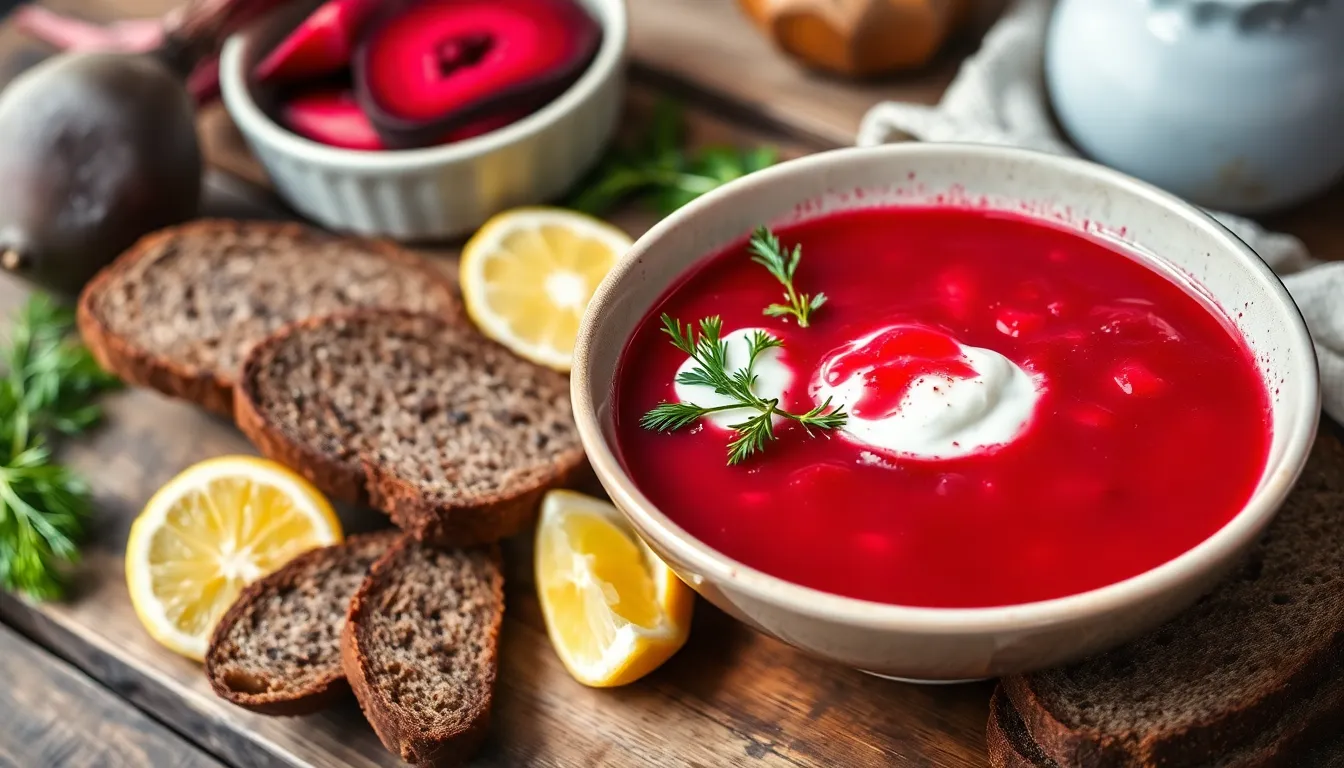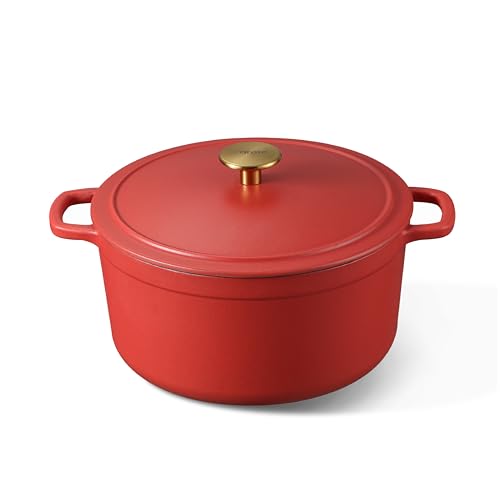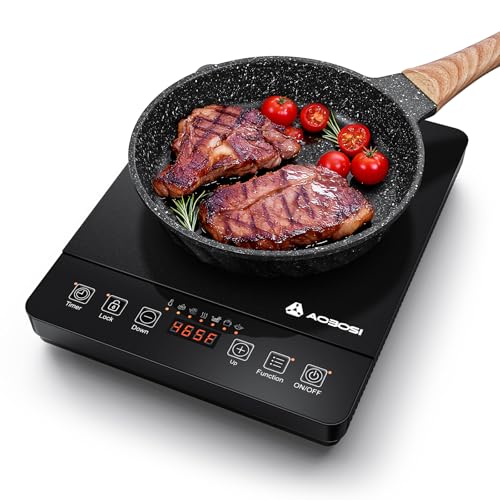Ingredients
This authentic borscht recipe requires fresh vegetables and simple pantry staples to create its signature deep flavor. Organize your ingredients by preparation stage for the smoothest cooking experience.
For the Beet Broth
- 2 pounds fresh beets, peeled and quartered
- 8 cups water
- 2 bay leaves
- 1 teaspoon salt
- 2 tablespoons white vinegar
- 1 medium onion, halved
For the Soup Base
- 3 tablespoons vegetable oil
- 1 large onion, diced
- 2 medium carrots, julienned
- 3 cups green cabbage, finely shredded
- 2 medium potatoes, peeled and diced
- 3 cloves garlic, minced
- 2 tablespoons tomato paste
- Salt and black pepper to taste
- 1 tablespoon sugar
- 2 tablespoons fresh lemon juice
For Serving and Garnish
- ½ cup sour cream
- 3 tablespoons fresh dill, chopped
- 2 green onions, sliced thin
- Dark rye bread for serving
- Additional lemon wedges
Equipment Needed
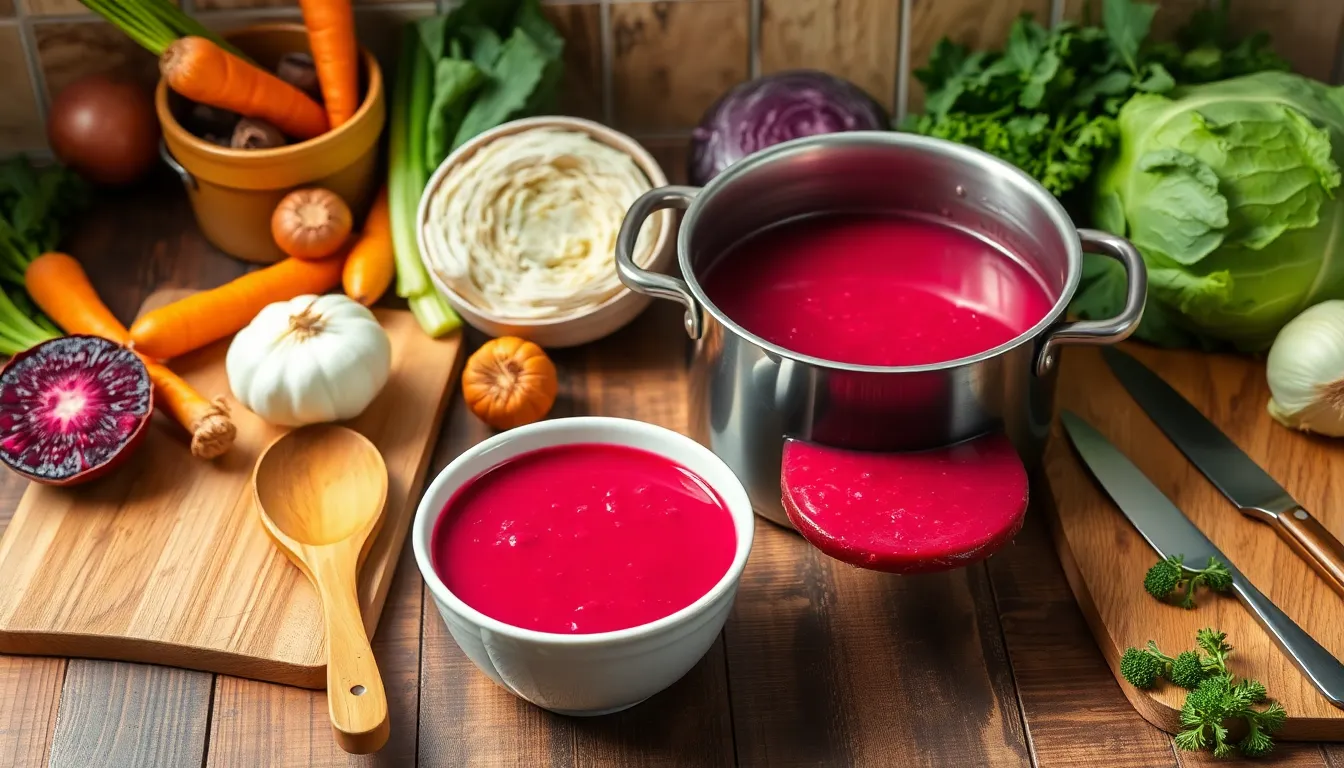
You need a few essential kitchen tools to create this authentic borscht recipe successfully. A large stockpot or Dutch oven serves as your primary cooking vessel for this hearty soup. This pot should hold at least 6 quarts to accommodate all the vegetables and broth comfortably.
Your cutting board and sharp chef’s knife become crucial for preparing the various vegetables. You’ll be dicing onions, julienning carrots, shredding cabbage, and cubing potatoes throughout the process. A vegetable peeler helps remove beet skins efficiently without staining your hands excessively.
A wooden spoon or ladle allows you to stir the soup gently while maintaining the vegetables’ texture. Metal utensils can sometimes react with the acidic ingredients in borscht. You’ll also need measuring cups and spoons for accurate ingredient portions.
A fine-mesh strainer becomes invaluable if you choose to strain the beet cooking liquid for a clearer broth. Some cooks prefer this method for a more refined soup appearance. A large mixing bowl catches the strained liquid during this optional step.
Individual soup bowls for serving complete your equipment list. Choose bowls that showcase the soup’s vibrant ruby color beautifully. Small spoons for adding sour cream garnish and soup spoons for eating round out your serving essentials.
Your standard kitchen tools like can opener (if using canned tomato paste), garlic press or microplane grater, and basic measuring equipment support the cooking process. These everyday items ensure smooth preparation from start to finish.
Instructions
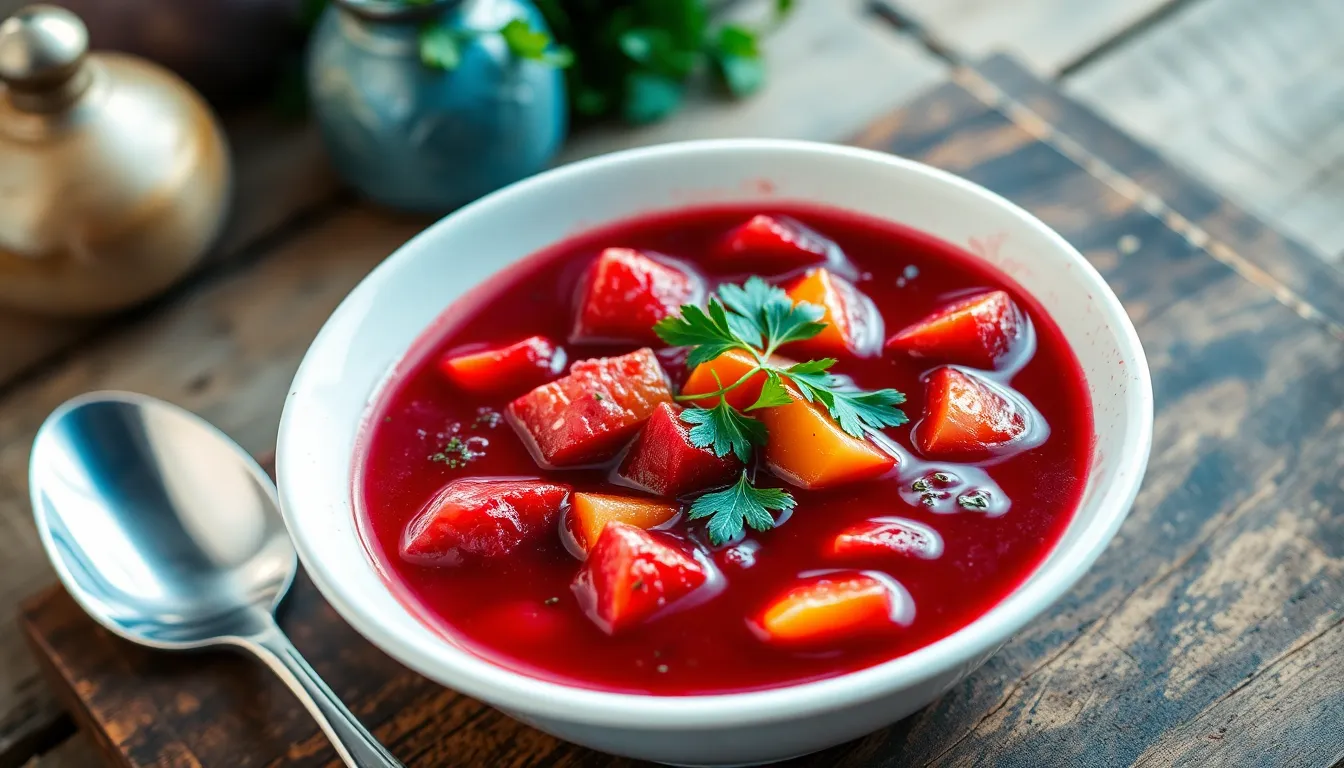
Creating authentic borscht requires careful attention to timing and technique to achieve the perfect balance of flavors. Follow these detailed steps to transform fresh beets and vegetables into a vibrant soup that captures the essence of traditional Eastern European cooking.
Prep the Beets and Vegetables
Wash the fresh beets thoroughly under cold running water and trim off the greens, leaving about 1 inch of stem attached. Peel the beets using a vegetable peeler and cut them into large chunks, approximately 2-inch pieces. Dice the onion into small, uniform pieces and set aside. Julienne the carrots into thin matchstick strips about 2 inches long. Shred the cabbage into thin ribbons using a sharp knife. Dice the potatoes into 1/2-inch cubes and place them in cold water to prevent browning. Mince the garlic cloves finely and have all prepared vegetables ready for cooking.
Make the Beet Broth
Place the chunked beets in your large stockpot with 8 cups of water. Add the bay leaves, 1 teaspoon of salt, and 2 tablespoons of vinegar to the pot. Bring the mixture to a rolling boil over high heat, then reduce the heat to medium-low and simmer for 45 minutes to 1 hour. The beets should be tender when pierced with a fork and the liquid should turn a deep ruby red color. Remove the beets from the broth using a slotted spoon and set them aside to cool. Strain the beet broth through a fine-mesh strainer if you prefer a clearer soup base. Reserve the cooked beets for later use or discard them if you prefer a vegetable-only soup.
Prepare the Soup Base
Heat the vegetable oil in the same stockpot over medium heat until shimmering. Add the diced onion and cook for 3-4 minutes until softened and translucent. Stir in the julienned carrots and cook for another 3 minutes until they begin to soften. Add the minced garlic and cook for 30 seconds until fragrant, being careful not to burn it. Stir in the tomato paste and cook for 1 minute to develop its flavor. Add the shredded cabbage to the pot and cook for 5 minutes, stirring occasionally, until it begins to wilt and reduce in volume.
Combine and Simmer
Pour the reserved beet broth back into the stockpot with the sautéed vegetables. Drain the diced potatoes and add them to the soup along with 1 teaspoon of sugar. Bring the mixture to a boil over high heat, then reduce the heat to medium-low and simmer for 20-25 minutes. The potatoes should be tender and the cabbage should be completely softened. Stir the soup occasionally to prevent sticking and ensure even cooking. Taste the broth and adjust the liquid level by adding more water if the soup appears too thick.
Final Seasoning and Adjustments
Add the remaining salt and black pepper to taste, starting with 1/2 teaspoon of each. Stir in the lemon juice to brighten the flavors and enhance the soup’s vibrant color. Remove the bay leaves and discard them. Taste the soup and adjust the seasoning as needed, adding more salt, pepper, lemon juice, or sugar to achieve the perfect balance of sweet, sour, and savory flavors. Let the soup rest for 5 minutes off the heat to allow the flavors to meld together before serving.
Directions for Serving
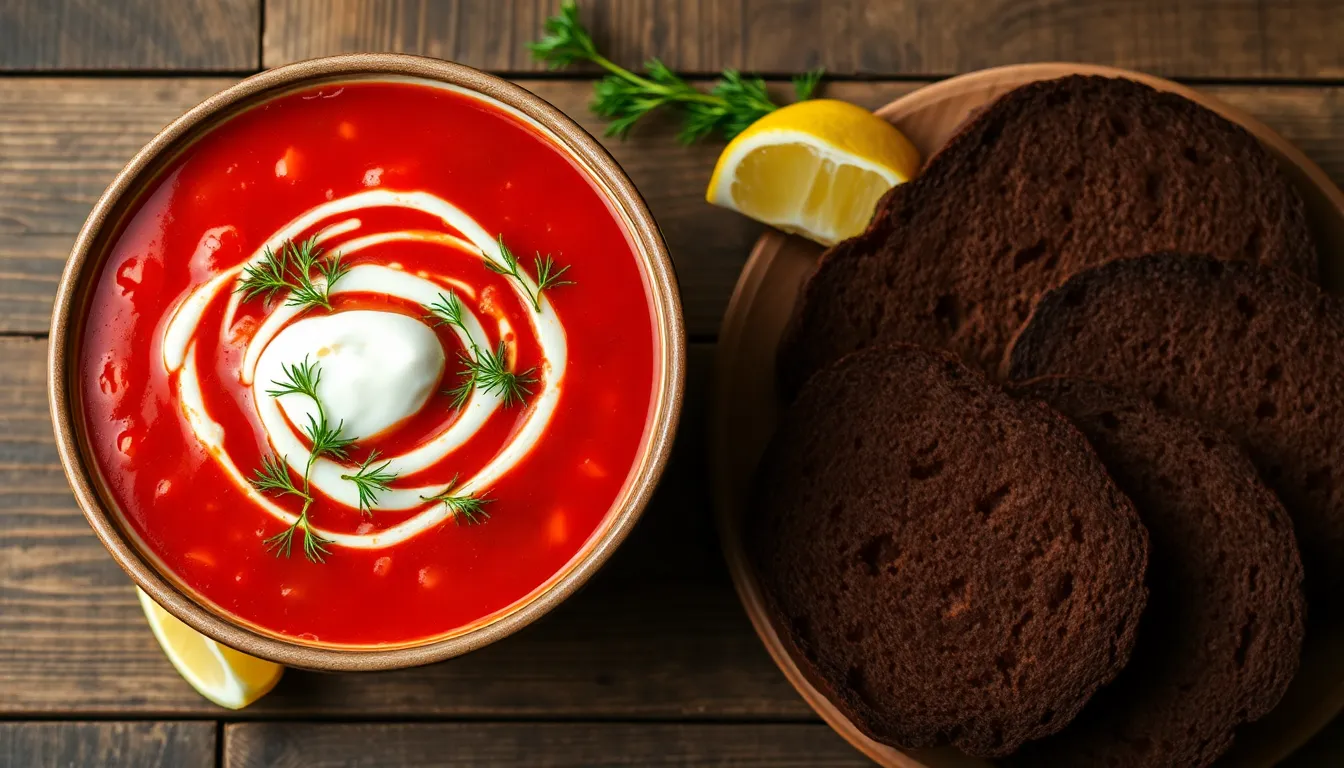
Proper serving enhances your homemade borscht’s authentic flavors and visual appeal. Your presentation choice transforms this hearty soup into either a traditional comfort meal or an elegant dining experience.
Traditional Serving Style
Serve your borscht hot in deep bowls to showcase its vibrant ruby-red color. Place a generous dollop of sour cream in the center of each serving and watch it create beautiful swirls as it melts into the soup. Sprinkle fresh dill over the surface for aromatic appeal and authentic Eastern European flavor.
Accompany each bowl with thick slices of dark rye bread on the side. The bread’s dense texture perfectly complements the soup’s rich consistency while providing a satisfying contrast. Add lemon wedges to each plate so guests can adjust the soup’s acidity to their preference.
Set the table with soup spoons rather than regular spoons to help guests enjoy the hearty chunks of vegetables. Provide small dishes for the bread and extra sour cream for those who prefer additional richness. This traditional approach honors the soup’s cultural heritage while creating a warming meal experience.
Modern Presentation Options
Create an elegant presentation by serving your borscht in shallow white bowls that highlight the soup’s striking color. Drizzle sour cream in artistic patterns across the surface using a squeeze bottle or small spoon. Garnish with microgreens or finely chopped chives instead of traditional dill for a contemporary touch.
Consider serving smaller portions as an appetizer course in shot glasses or small cups for dinner parties. This approach allows guests to experience the soup’s bold flavors without overwhelming the meal. Provide small spoons and arrange the servings on a decorative tray.
For summer entertaining serve chilled borscht in chilled bowls with cucumber ribbons and a sprinkle of everything bagel seasoning. This modern twist maintains the soup’s authentic taste while adapting to warmer weather preferences. Pair with artisanal crackers or crostini instead of traditional rye bread for a lighter presentation.
Make-Ahead Instructions
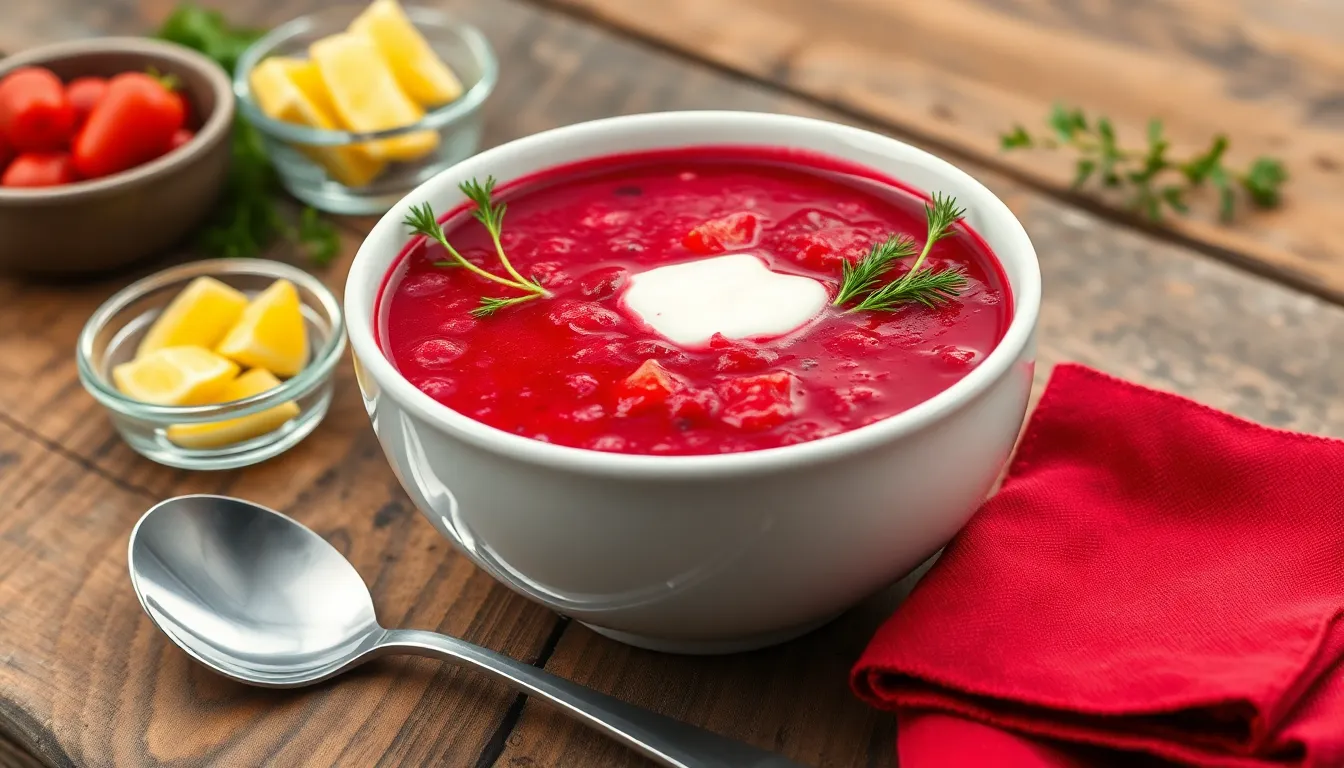
This borscht recipe works beautifully as a make-ahead meal since the flavors actually improve after sitting overnight. You can prepare the entire soup up to three days in advance for stress-free entertaining.
Storage Tips
Store your cooled borscht in airtight containers in the refrigerator for up to 4 days. The soup’s flavor deepens during storage as the vegetables continue to meld with the beet broth. You can also freeze portions in freezer-safe containers for up to 3 months though the texture of potatoes may become slightly softer after thawing.
Divide large batches into smaller containers for easier reheating and portion control. Label containers with the date to track freshness. Keep garnishes like sour cream and fresh dill separate until serving time to maintain their quality and prevent the soup from becoming watery.
Reheating Guidelines
Reheat refrigerated borscht gently on the stovetop over medium-low heat stirring occasionally until warmed through. Add a splash of water or vegetable broth if the soup has thickened during storage. Taste and adjust seasoning with salt pepper or lemon juice as flavors may need refreshing after storage.
For frozen borscht thaw overnight in the refrigerator before reheating. Microwave individual portions in 30-second intervals stirring between each interval until heated evenly. Avoid boiling during reheating as this can break down the vegetables and affect the soup’s texture.
Fresh garnishes should always be added just before serving regardless of the reheating method. This ensures your make-ahead borscht maintains its authentic appearance and fresh flavor profile.
Recipe Variations
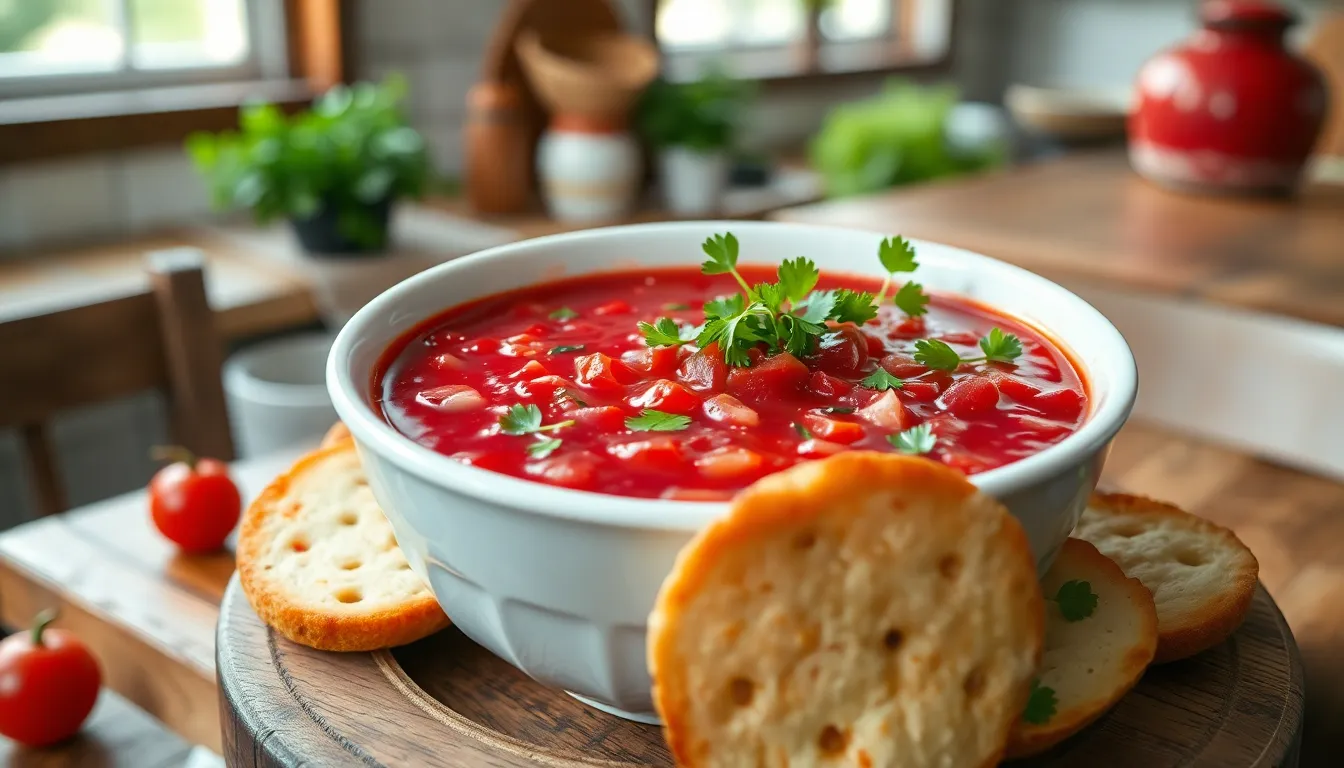
Transform your borscht into distinct regional specialties by adjusting key ingredients and preparation methods. Each variation captures the authentic flavors of its cultural origin while maintaining the soup’s signature ruby-red appearance.
Ukrainian-Style Borscht
Prepare traditional Ukrainian borscht by adding kidney beans and beef short ribs to create a hearty main course. Soak 1 cup of dried kidney beans overnight before cooking them separately until tender. Brown 2 pounds of beef short ribs in the stockpot before adding the beet broth. Simmer the meat for 2 hours until fork-tender before proceeding with the vegetable preparation.
Include fresh parsnips alongside your carrots for authentic flavor depth. Add 2 medium diced parsnips when you sauté the vegetables. Ukrainian cooks traditionally finish their borscht with a generous amount of fresh dill and parsley. Stir in ¼ cup of chopped fresh herbs during the final 5 minutes of cooking.
Serve Ukrainian borscht with pampushky (garlic bread rolls) instead of rye bread. The rich broth pairs perfectly with these traditional yeasted rolls brushed with garlic oil.
Russian-Style Borscht
Create Russian borscht by incorporating meat stock and additional root vegetables for a more complex flavor profile. Replace half of your water with beef or chicken stock when preparing the beet broth. Add 2 medium diced turnips and 1 large diced parsnip to your vegetable mixture.
Russian recipes often include a touch of paprika for subtle smokiness. Add 1 teaspoon of sweet paprika when you sauté the onions and carrots. Some regions also incorporate bell peppers by adding 1 diced red bell pepper with the cabbage.
Finish Russian borscht with a traditional smetana (sour cream) mixture. Blend ½ cup sour cream with 2 tablespoons of the hot broth before stirring it back into the soup. This technique prevents curdling while creating a creamy texture throughout.
Vegetarian and Vegan Options
Develop plant-based borscht by substituting vegetable stock for water and omitting all animal products. Use mushroom stock for deeper umami flavors or combine vegetable stock with 2 tablespoons of soy sauce for richness.
Replace sour cream with cashew cream for vegan serving. Blend ½ cup soaked raw cashews with ¼ cup water until smooth and creamy. Add 1 tablespoon of lemon juice and a pinch of salt to mimic the tangy flavor of traditional sour cream.
Enhance vegetarian versions with protein-rich additions like white beans or lentils. Add 1 cup of cooked cannellini beans during the final 10 minutes of cooking. For lentil borscht, incorporate ½ cup of red lentils with the vegetables and extend cooking time by 15 minutes until tender.
Boost umami in plant-based versions by adding 2 tablespoons of tomato paste and 1 teaspoon of smoked paprika. These ingredients compensate for the absence of meat while maintaining the soup’s satisfying depth of flavor.
Tips for Perfect Borscht
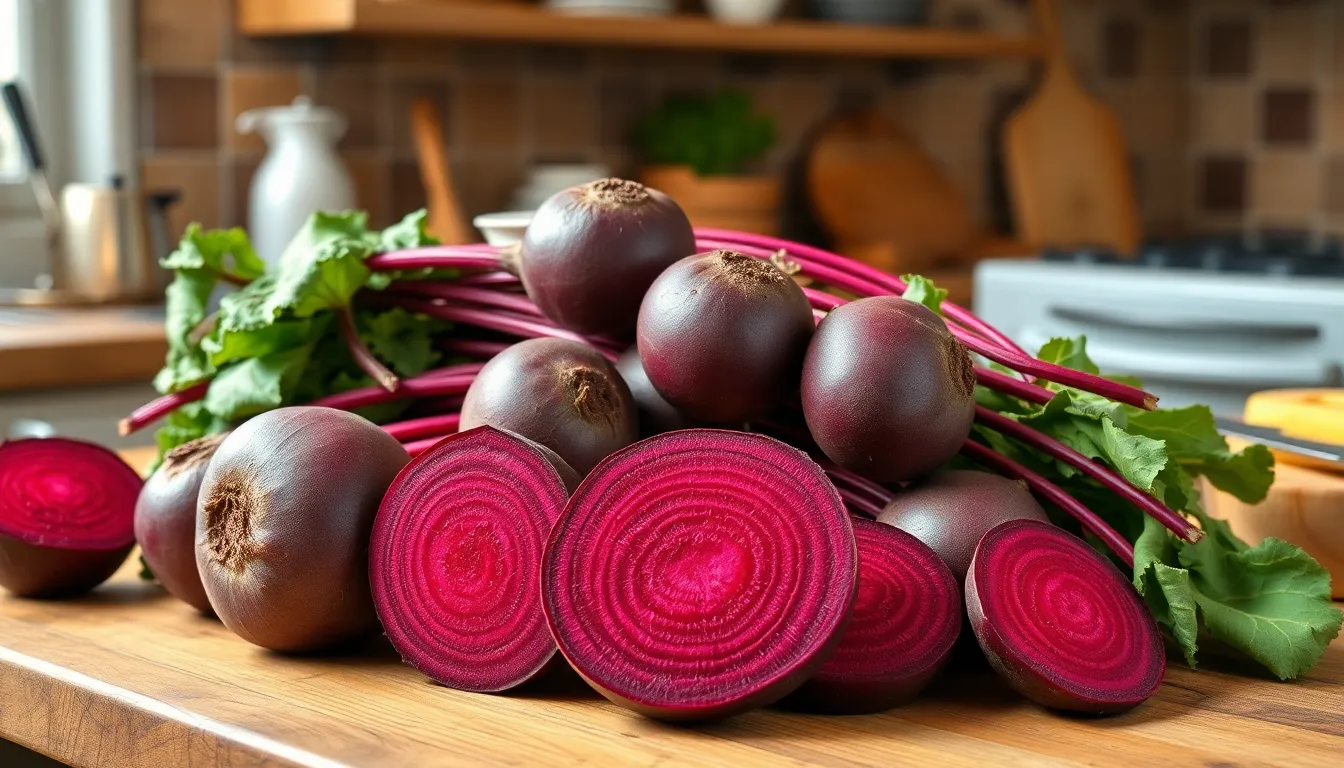
Mastering the art of borscht requires attention to key details that separate good soup from exceptional soup. These essential techniques will help you create restaurant-quality borscht with vibrant color and authentic flavor.
Selecting the Best Beets
Choose beets that feel firm and heavy with smooth, unblemished skin for the most flavorful broth. Fresh beets should have their greens still attached, indicating recent harvest and optimal freshness. Medium-sized beets work best as they cook evenly and provide the right balance of sweetness and earthiness.
Store your beets in the refrigerator crisper drawer for up to two weeks before using them in your recipe. Look for beets with deep red color throughout when you cut them open, as pale or striped varieties will produce less vibrant soup. Avoid beets that feel soft, have wrinkled skin, or show signs of sprouting, as these indicate age and diminished flavor.
Wear gloves when handling raw beets to prevent staining your hands and cutting board. Wash beets thoroughly under cold running water and scrub away any dirt before peeling. Save the beet greens for sautéing as a nutritious side dish or adding to salads.
Achieving the Right Color and Flavor
Add vinegar or lemon juice to your beet broth early in the cooking process to preserve the brilliant red color. The acid prevents the natural pigments from breaking down and turning brown during cooking. Use approximately one tablespoon of acid per quart of liquid for optimal color retention.
Grate one raw beet and add it during the final fifteen minutes of cooking to intensify both color and fresh beet flavor. This technique provides an extra boost of vibrant hue while maintaining some texture in your finished soup. Balance the natural earthiness of beets with a pinch of sugar to enhance their sweetness.
Taste your borscht before serving and adjust the sweet-sour balance with additional lemon juice or sugar as needed. The soup should have a pleasant tartness that complements rather than overwhelms the beet flavor. Allow the finished soup to rest for at least thirty minutes before serving to let all flavors meld together perfectly.
Strain your beet cooking liquid through a fine-mesh sieve to remove any particles and ensure a smooth, clear broth. Keep the cooking temperature at a gentle simmer rather than a rolling boil to prevent the color from becoming muddy.
Conclusion
You now have everything you need to create an authentic borscht that’ll rival any Eastern European grandmother’s recipe. This vibrant beet soup isn’t just a meal – it’s a celebration of tradition that brings warmth and nourishment to your table.
Your homemade borscht will taste even better the next day so don’t hesitate to make it ahead for stress-free entertaining. Whether you serve it steaming hot with crusty rye bread or chilled on a summer afternoon the rich flavors will transport you straight to the heart of Eastern Europe.
With these techniques and variations in your culinary toolkit you’re ready to make borscht a beloved staple in your kitchen. Your family and friends will be impressed by both the stunning ruby-red presentation and the deeply satisfying flavors you’ve mastered.

